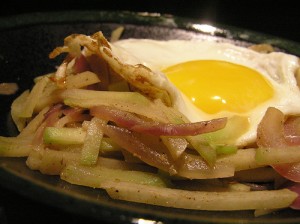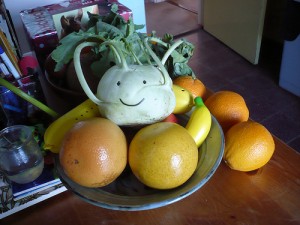Kohlrabi is one of those vegetables that you probably never heard of until you started the low oxalate diet. It seems most American chefs and home cooks have never heard of it either, or at least don’t cook with it. I own at least 20 cookbooks and only Molly Katzen, author of the Enchanted Broccoli Forest, mentions kohlrabi, although she doesn’t give a recipe – just good advice to try this wonderful, weird little veggie if you haven’t already. At 0.6 mg. oxalate per half cup, sliced, I agree. This is one very low oxalate veggie worth getting acquainted with!
Kohlrabi is German for “cabbage turnip.” In his book “The 150 Healthiest Foods on Earth,” the nutritionist Jonny Bowden describes kohlrabi as a cross between an octopus and a space capsule. It does look slightly alien, especially if it still has the leaves or stems. Kohlrabi is a member of the brassica family and is a good source of potassium, vitamins C and A, calcium, fiber and antioxidants. It can be eaten raw or cooked, and tastes a little like a sweet, mild cross between a cabbage and a radish, or as Elizabeth Schneider, in her classic Uncommon Fruits and Vegetables, put it: kohlrabi tastes “like the freshest, crunchiest broccoli stems, touched with a hint of radish and cucumber.” Both the leaves and the bulb (which is actually its swollen stem, not its root) are edible and tasty. We only know the oxalate content of the bulb (0.6 mg. oxalate per half cup), but all members of the brassica family are either low or medium oxalate, so it is likely that the leaves of kohlrabi are also low or medium oxalate.
If you plan to eat kohlrabi raw, try to find smallish bulbs – 2-3 inches in diameter. Peel them until you reach the juicy center and enjoy! The larger bulbs (3-5 inches diameter) tend to get somewhat fibrous and could benefit from cooking. You may also notice on the larger bulbs that the peel comes in two layers, the tough peel and a fibrous undercoating. Be sure to peel down to the juicy, tender part of the bulb (double peeling usually is enough) or you may end up with a tough outer layer that doesn’t get tender when cooked. If you end up growing monster bulbs in your own garden (greater than 5 inches diameter), go ahead and cook them. They may still make a tasty mashed veggie dish with butter, but don’t buy the really big bulbs at the store. The smaller, juicier ones are usually much better.

Kohlrabi nested Egg! Here the Kohlrabi is cut into matchsticks instead of the half inch dice and sauteed like hash browns! A fabulous way to keep your breakfast low oxalate, GAPS -legal, Paleo and nutritious!
The really good news about kohlrabi, besides it being very low oxalate, is its versatility. You can eat kohlrabi raw in salads, or you can eat it roasted, boiled, steamed, sauteed or blanched. When left raw, it soaks up dressings very well, making it the perfect vegetable for shredding into slaws or other dressed salads. You can even cut it into coins, similar to cucumbers, and use it as a substitute for crackers in your summer appetizers. Kohlrabi can also be boiled and mashed with root vegetables such as turnips, to make a yummy alternative to mashed potatoes. It fact, it has a slightly earthy taste and texture when roasted, similar to a mild turnip. Plus, it pairs well with cheese and cream sauces, making it a fabulous addition to casseroles and savory rice dishes. I’ve substituted kohlrabi for half the brussel sprouts in Roasted Brussel Sprouts and for half the cauliflower in Mashed Cauliflower – both with fantastic results. You can also use kohlrabi in almost any dish that calls for turnips or cabbage, although sometimes the kohlrabi needs a little more cooking time to reach the same tenderness as its namesakes.
I’ve harvested a bumper crop of kohlrabi from my garden this year, so I hope to share a few of my old favorite recipes, plus try a few new recipes over the next few weeks. Here’s a simple one to get you started: roasted kohlrabi. After all, what veggie doesn’t improve with simple roasting?
Roasted Kohlrabi
3 cups kohlrabi (3-6 kohlrabi bulbs depending on size)
2 tablespoons olive oil
1 clove garlic, minced
salt to taste (start with 1/4 teaspoon)
1/2 teaspoon white pepper
1/2 teaspoon thyme (optional)
Peel the kohlrabi until you reach the juicy inside flesh, then dice the kohlrabi into half inch pieces. Put the olive oil, garlic, salt, pepper and thyme in a bowl and mix well. Add the kohlrabi and toss with the oil mixture until all pieces are coated. Spread the kohlrabi on a baking sheet or in a glass baking dish. Roast at 400 degrees, stirring every 5-8 minutes after 20 minutes, for about 35-40 minutes until the kohlrabi is fork tender.
Serves 6
Variations: Prepare the kohlrabi as above, except braise the kohlrabi in a skillet over medium heat instead of roasting it. Yum!
You may also cut it into match-sticks (or any other shape you like), leave out the thyme and brown it in the skillet like hash browns for a fabulous low oxalate, Paleo, and GAPS-legal breakfast treat (see above). This is especially yummy if you use lard, bacon fat, butter or ghee instead of olive oil.
Low Oxalate Info: Roasted Kohlrabi has about 1 mg. oxalate per serving, so go ahead and have seconds or thirds!
Other Diets: Roasted Kohlrabi may also be appropriate for GAPS, SCD, Paleo, vegetarian, vegan, GFCF, gluten-free, dairy-free and low carb diets.
Photo Credits go to dichohecho for smile and to Laurel Fan for Kohlrabi Nested Egg.




{ 5 comments… read them below or add one }